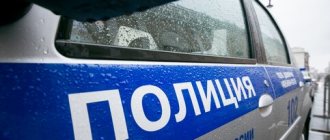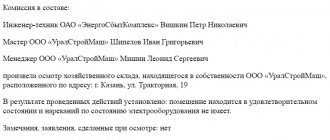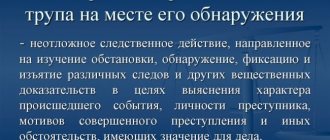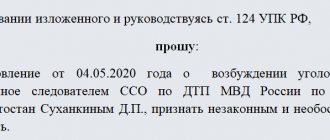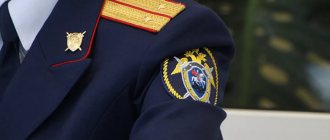Preparing to inspect the scene of the incident
Inspection of the crime scene can be defined as an urgent, initial investigative action, consisting of a direct examination by the investigator of the situation at the scene of the crime, the traces and other objects located on it, their recording and removal in order to obtain factual data relevant for the detection and investigation of the crime.
The success of the crime scene examination largely depends on how well the investigator prepared for it. However, it should be noted that there is usually no time for its thorough preparation, since going to the scene of the incident must be carried out immediately after receiving a report of the incident.
The stage of preparation for the inspection of the scene of the incident is divided into two stages, providing for:
- actions of the investigator before leaving for the scene of the incident;
- actions of the investigator upon arrival at the scene of the incident.
Actions of the investigator before leaving the scene of the incident
At the first stage, having received a report of an incident, the investigator must first of all:
- clarify what happened and where,
- take measures to provide assistance to the victims, if it has not already been provided,
- take measures to restore order and safety of citizens in areas adjacent to the scene of the incident;
- take urgent measures to protect the scene of the incident, ensure the presence of eyewitnesses before the investigator arrives;
- when preparing for departure, check the availability of technical equipment;
- order (ensure the availability) of vehicles necessary to go to the scene of the incident, to send the victim to the hospital, the corpse to the morgue, to deliver material evidence seized from the scene of the incident;
- determine the circle of persons who should participate in the inspection (police operatives, specialists in the field of forensic science, forensic medicine, fire protection, etc.).
The scene of the incident must be preserved in its original, unchanged form. Its protection can be carried out by persons who discovered the incident and reported it, police officers, administration of enterprises and institutions, employees of local authorities, etc.
Actions of the investigator upon arrival at the scene of the incident
Upon arrival at the scene of the incident, the investigator:
- makes sure that assistance has been provided to the victim;
- checks whether the situation at the scene of the incident has changed (based on a brief interview with the victim, eyewitnesses and other persons who were there);
- removes unauthorized persons;
- defines the role of each inspection participant, explains to them their rights and responsibilities;
- gives orders to police officers to carry out operational search activities (identifying crime suspects, eyewitnesses, witnesses, identifying places where stolen property is hidden, the crime weapon, etc.).
Upon completion of the preparatory activities, the investigator begins to inspect the scene of the incident. In order to better organize work at the scene of an incident, standard programs are drawn up and actively used - algorithms for the actions of members of the investigative and operational team.
0
1.2
Actions of the SOG participants at the scene of the incident
Investigator:
— manages the SOG on duty, determines the order of its work, ensures the coordination of the actions of its personnel to identify the victims, eyewitnesses of the incident and the perpetrators of the crime; carries out work to collect (detection, recording and seizure) traces of a criminal act;
— before leaving for the scene of the incident, determines the optimal composition of the members of the special task force, informs them about the incident, assigns each of them tasks to carry out urgent measures;
— if necessary, involves, through the operational duty officer of the police department, additional specialists and other persons (for example, employees of the patrol service * (161)) to participate in the inspection of the scene of the incident;
- allows, in cases provided for by law, access to the scene of the incident of persons who do not officially participate in the inspection (including representatives of the media (hereinafter referred to as the media)).
- inspects the scene of the incident, during which:
1) records the time of arrival at the crime scene;
2) removes unauthorized persons from the inspection site, including police officers who do not take part in the inspection or security of the scene. Admission to the scene of the incident of persons not officially participating in its inspection is made only with the permission of the investigator (inquiry officer);
3) determines the circle of specialists to participate in the inspection of the scene of the incident;
4) takes measures to identify the victim and provide assistance to him;
5) receives primary information from internal affairs officers who were the first to arrive at the scene of the incident (for example, a police squad, etc.); establishes what changes have been made to the situation at the scene of the incident; determines the boundaries of the inspection and the procedure for conducting it;
6) identifies and briefly interviews eyewitnesses of the incident;
7) attracts relevant persons with special knowledge to the inspection of the scene of the incident: a forensic expert, a forensic physician (in case of harm to the health of the victim) or another specialist;
summarizes and analyzes information received by him from eyewitnesses, participants in the inspection of the scene of the incident and other persons that is of interest for putting forward and verifying investigative leads;
9) puts forward versions, taking into account information received at the scene of the incident, and plans the implementation of urgent measures aimed at solving the crime. For this purpose, he gives instructions to employees of operational units to carry out the necessary operational measures, and exercises other powers provided for by the criminal procedure law;
10) informs the members of the Special Investigation Team about the facts and circumstances known to him that are important for identifying and hot pursuit of the persons who committed the crime;
11) personally draws up a protocol for the inspection of the scene of the incident and bears personal responsibility for its quality;
12) upon completion of the inspection of the scene of the incident, as well as interviewing eyewitnesses and victims about the circumstances of the crime committed, gathers members of the Special Investigation Team and sums up the work done.
Operations officer:
- having arrived at the scene of the incident first, takes measures to preserve the original situation, and in the absence of the investigator, conducts an inspection of the scene of the incident. As a member of the SOG:
- gets acquainted with the circumstances of the incident to determine the direction of the search and take operational-search and other measures to identify and detain persons involved in the crime;
— resolves the issue of the dog handler’s use of a service-search dog;
— establishes the identity of the victim;
— identifies eyewitnesses to the crime, persons who can report something about the incident, suspects, lifestyle of the victim, etc.; for these purposes, together with the local police commissioner, he goes around the territory (households, apartments);
— conducts a survey of eyewitnesses and the victim about the circumstances of the crime known to them and the persons involved in it;
— maintains contact with the police department on duty;
- systematically, as data is received that is of operational interest for solving the crime, informs the investigator about it; takes measures to apprehend the criminal without delay;
— informs the operational duty officer of the internal affairs department information about the nature of the crime; signs of the persons who committed it;
— identifies from the records of persons previously convicted of similar crimes, those who are prone to committing them and who are registered at their place of residence, etc.; takes measures to verify their involvement in the crime;
— carries out operational investigations aimed at identifying, detecting and detaining persons suspected of committing a crime; checks seized items according to operational and forensic records; identifies eyewitnesses of the incident, as well as places of storage and sale of stolen goods;
- carries out the instructions of the investigator and informs him about the results of participation in the inspection of the crime scene and measures to identify the persons who committed the crime;
- draws up a detailed report on the work done addressed to the head of the internal affairs agency.
An employee of the forensic unit when visiting the scene of an incident:
— exercises the procedural powers of a specialist (Article 58 of the Code of Criminal Procedure of the Russian Federation);
— discusses with the investigator the need and sequence of using certain technical means;
— determines the advisability of involving other specialists in the inspection of the crime scene, clarifies the sequence of actions to detect, record and seize traces and material evidence;
— agrees with the investigator on the procedure and method of photographing (video) filming the scene of the incident, selects and photographs objects;
— draws the investigator’s attention to the circumstances associated with the discovery, securing and seizure of objects and documents; gives explanations regarding the actions he performs;
— assists the investigator in the detection and seizure, packaging, as well as preservation of objects and traces of a crime, selection of comparative and control samples;
- conducts research of objects and traces at the scene to obtain information about the circumstances of the crime and the persons involved in its commission.
District police commissioner:
— if it is impossible for the on-duty SOG or employees of the operational units to arrive at the scene of the incident, conduct an inspection of it, and also perform other actions to establish the circumstances of the crime and the persons involved in it.
When going to the scene of an incident as part of the special task force:
— takes measures to protect the scene of the incident, as well as material assets and documentation;
— invites citizens as witnesses to participate in the inspection of the scene of the incident;
- finds out the circumstances of the crime committed and the persons involved in it and informs the investigator about this;
- carries out other assignments of the investigator.
In addition, he informs the investigator, investigator, and operational officers about persons living or appearing in the area of the incident who are of relevant interest to the preliminary investigation authorities and assists the employees of the operational unit in the pursuit and detention of persons suspected of committing a crime.
Dog inspector:
- coordinates with the investigator the use of a search dog to search for persons who committed a crime, weapons, other objects, as well as camouflaged shelters;
- takes part in the prosecution and detention of persons suspected of committing a crime;
— draws up an act on the use of a service-search dog or a report indicating the reasons for its non-use.
Patrol service employees:
- take measures to suppress the crime;
— organize and carry out the prosecution and detention of criminals;
— provide assistance to victims, call an ambulance if necessary;
— if possible, identify eyewitnesses to the crime;
- provide security at the scene of the incident;
- remove all citizens from the scene of the incident to a distance that excludes the possibility of destruction or damage to traces and material evidence.
Investigator:
— manages the SOG on duty, determines the order of its work, ensures the coordination of the actions of its personnel to identify the victims, eyewitnesses of the incident and the perpetrators of the crime; carries out work to collect (detection, recording and seizure) traces of a criminal act;
— before leaving for the scene of the incident, determines the optimal composition of the members of the special task force, informs them about the incident, assigns each of them tasks to carry out urgent measures;
— if necessary, involves, through the operational duty officer of the police department, additional specialists and other persons (for example, employees of the patrol service * (161)) to participate in the inspection of the scene of the incident;
- allows, in cases provided for by law, access to the scene of the incident of persons who do not officially participate in the inspection (including representatives of the media (hereinafter referred to as the media)).
- inspects the scene of the incident, during which:
1) records the time of arrival at the crime scene;
2) removes unauthorized persons from the inspection site, including police officers who do not take part in the inspection or security of the scene. Admission to the scene of the incident of persons not officially participating in its inspection is made only with the permission of the investigator (inquiry officer);
3) determines the circle of specialists to participate in the inspection of the scene of the incident;
4) takes measures to identify the victim and provide assistance to him;
5) receives primary information from internal affairs officers who were the first to arrive at the scene of the incident (for example, a police squad, etc.); establishes what changes have been made to the situation at the scene of the incident; determines the boundaries of the inspection and the procedure for conducting it;
6) identifies and briefly interviews eyewitnesses of the incident;
7) attracts relevant persons with special knowledge to the inspection of the scene of the incident: a forensic expert, a forensic physician (in case of harm to the health of the victim) or another specialist;
9) puts forward versions, taking into account information received at the scene of the incident, and plans the implementation of urgent measures aimed at solving the crime. For this purpose, he gives instructions to employees of operational units to carry out the necessary operational measures, and exercises other powers provided for by the criminal procedure law;
10) informs the members of the Special Investigation Team about the facts and circumstances known to him that are important for identifying and hot pursuit of the persons who committed the crime;
11) personally draws up a protocol for the inspection of the scene of the incident and bears personal responsibility for its quality;
12) upon completion of the inspection of the scene of the incident, as well as interviewing eyewitnesses and victims about the circumstances of the crime committed, gathers members of the Special Investigation Team and sums up the work done.
Operations officer:
- having arrived at the scene of the incident first, takes measures to preserve the original situation, and in the absence of the investigator, conducts an inspection of the scene of the incident. As a member of the SOG:
- gets acquainted with the circumstances of the incident to determine the direction of the search and take operational-search and other measures to identify and detain persons involved in the crime;
— resolves the issue of the dog handler’s use of a service-search dog;
— establishes the identity of the victim;
— identifies eyewitnesses to the crime, persons who can report something about the incident, suspects, lifestyle of the victim, etc.; for these purposes, together with the local police commissioner, he goes around the territory (households, apartments);
— conducts a survey of eyewitnesses and the victim about the circumstances of the crime known to them and the persons involved in it;
— maintains contact with the police department on duty;
- systematically, as data is received that is of operational interest for solving the crime, informs the investigator about it; takes measures to apprehend the criminal without delay;
— informs the operational duty officer of the internal affairs department information about the nature of the crime; signs of the persons who committed it;
— identifies from the records of persons previously convicted of similar crimes, those who are prone to committing them and who are registered at their place of residence, etc.; takes measures to verify their involvement in the crime;
— carries out operational investigations aimed at identifying, detecting and detaining persons suspected of committing a crime; checks seized items according to operational and forensic records; identifies eyewitnesses of the incident, as well as places of storage and sale of stolen goods;
- carries out the instructions of the investigator and informs him about the results of participation in the inspection of the crime scene and measures to identify the persons who committed the crime;
- draws up a detailed report on the work done addressed to the head of the internal affairs agency.
An employee of the forensic unit when visiting the scene of an incident:
— exercises the procedural powers of a specialist (Article 58 of the Code of Criminal Procedure of the Russian Federation);
— discusses with the investigator the need and sequence of using certain technical means;
— determines the advisability of involving other specialists in the inspection of the crime scene, clarifies the sequence of actions to detect, record and seize traces and material evidence;
— agrees with the investigator on the procedure and method of photographing (video) filming the scene of the incident, selects and photographs objects;
— draws the investigator’s attention to the circumstances associated with the discovery, securing and seizure of objects and documents; gives explanations regarding the actions he performs;
— assists the investigator in the detection and seizure, packaging, as well as preservation of objects and traces of a crime, selection of comparative and control samples;
- conducts research of objects and traces at the scene to obtain information about the circumstances of the crime and the persons involved in its commission.
District police commissioner:
— if it is impossible for the on-duty SOG or employees of the operational units to arrive at the scene of the incident, conduct an inspection of it, and also perform other actions to establish the circumstances of the crime and the persons involved in it.
When going to the scene of an incident as part of the special task force:
— takes measures to protect the scene of the incident, as well as material assets and documentation;
— invites citizens as witnesses to participate in the inspection of the scene of the incident;
- finds out the circumstances of the crime committed and the persons involved in it and informs the investigator about this;
- carries out other assignments of the investigator.
In addition, he informs the investigator, investigator, and operational officers about persons living or appearing in the area of the incident who are of relevant interest to the preliminary investigation authorities and assists the employees of the operational unit in the pursuit and detention of persons suspected of committing a crime.
Dog inspector:
- coordinates with the investigator the use of a search dog to search for persons who committed a crime, weapons, other objects, as well as camouflaged shelters;
- takes part in the prosecution and detention of persons suspected of committing a crime;
— draws up an act on the use of a service-search dog or a report indicating the reasons for its non-use.
Patrol service employees:
- take measures to suppress the crime;
— organize and carry out the prosecution and detention of criminals;
— provide assistance to victims, call an ambulance if necessary;
— if possible, identify eyewitnesses to the crime;
- provide security at the scene of the incident;
- remove all citizens from the scene of the incident to a distance that excludes the possibility of destruction or damage to traces and material evidence.
Sample job description for an investigator of the Ministry of Internal Affairs
General provisions
- An investigator of the Ministry of Internal Affairs is hired in accordance with the established procedure, by order of the head of the relevant department.
- The investigator of the Ministry of Internal Affairs reports to the head of the investigative unit.
- An investigator of the Ministry of Internal Affairs undergoes regular re-certification in the manner prescribed in the relevant documentation.
- The work schedule of an investigator of the Ministry of Internal Affairs is determined on the basis of internal documents of the unit.
- A person applying for this position must meet the following requirements:
- legal education;
- successfully passed the medical examination and professional selection;
- availability of a set of necessary documents.
- The procedure for replacing an investigator in the event of his absence (illness, business trip, etc.) is determined by the head of the investigative unit based on current regulations.
- The investigator of the Ministry of Internal Affairs is obliged to understand the following issues:
- current legal framework governing investigative activities;
- principles of interaction with other representatives of law enforcement agencies;
- the order of subordination and hierarchy of the relevant units;
- principles of maintaining the necessary document flow;
- theoretical foundations of criminology, criminology, jurisprudence;
- methods of working with witnesses, victims, suspects and other persons;
- principles of classification of various types of illegal actions;
- methods of applying advanced achievements of criminology;
- parameters for using relevant technology and equipment;
- algorithms for investigating illegal actions;
- principles of examination and processing of the results obtained;
- rules for conducting an inspection of the scene of an incident;
- principles of working with photographic images;
- rules for documenting the results obtained;
- norms and tactics of interrogation;
- algorithms for conducting investigative actions, the need for which was identified during investigations;
- standards of ethics for law enforcement officials;
- rules for working with office equipment and specialized software;
- labor discipline standards, labor protection and fire safety rules.
- The investigator of the Ministry of Internal Affairs is guided by:
- the current regulatory framework;
- relevant documentation of the Ministry of Internal Affairs;
- internal documentation of the department;
- the contents of this manual.
Responsibilities
The investigator of the Ministry of Internal Affairs is assigned the following functions:
- Interaction with other law enforcement officials on issues of their professional activities.
- Ensuring the safety of data obtained during the investigation.
- Planning and carrying out the necessary investigative activities.
- Detection of motives and circumstances significant for the investigation of offenses.
- Issuing instructions for conducting examinations and other investigative actions.
- Preparation and submission of requests to the appropriate authorities, within their competence.
- Drawing up protocols, plans, diagrams and other investigative documents.
- Taking measures to identify those responsible for criminal acts.
- Conducting interviews with witnesses and victims and examining the scene of the incident.
- Formation of the evidence base necessary to bring charges.
- Referral of cases for filing charges.
- Resumption of the investigation when new significant circumstances are identified.
- Closing cases if there are sufficient grounds for this.
- Ensuring the rights guaranteed by current legislation to persons participating in a criminal investigation.
- Participation in the activities of investigative groups, within the boundaries of established responsibility.
- Ensuring the maintenance and preservation of necessary documentation.
- Compliance with labor discipline standards and fire safety rules.
Responsibility
The investigator of the Ministry of Internal Affairs is responsible in the following situations:
- For disclosure of confidential information - in the manner prescribed in the articles of the relevant legislation.
- For failure to fulfill their professional functions - within the limits given in the documentation of the Ministry of Internal Affairs and relevant legal acts.
- For violations of regulations and legislative acts - in accordance with the provisions of administrative, labor, and criminal law.
- In other cases provided for by the rules of the Ministry of Internal Affairs and current legislation.
Rights
An investigator of the Ministry of Internal Affairs has the following set of rights:
- Sign documents within your competence.
- Initiate cases in the order specified in the provisions of the Code of Criminal Procedure.
- Accept criminal cases for production and transfer in accordance with the established procedure.
- Direct investigations into pending cases.
- Carry out the necessary investigative actions within the boundaries determined by the Code of Criminal Procedure.
- Obtain court decisions and necessary consents from the heads of relevant departments.
- Give instructions to the inquiry authorities to carry out investigative measures necessary for the investigation.
- In accordance with the established procedure, appeal the actions of the prosecutor's office to cancel decisions to initiate criminal cases.
- Apply other rights specified in the Code of Criminal Procedure and relevant legislation.
Document composition options
The procedure for developing instructions for its employees is defined in Order of the Ministry of Internal Affairs dated February 1, 2018 No. 50. Section IX, paragraphs 174-184, contains the main characteristics that the instructions for employees of the Ministry of Internal Affairs must comply with. According to these points, the document must include 4 mandatory parts:
- General provisions.
- Job responsibilities.
- Responsibility of the investigator.
- Employee rights.
Basic requirements for the content of these sections are also specified in this regulatory act. Any instructions used in the units of the Ministry of Internal Affairs must be drawn up taking into account the provisions of this Order and the relevant sections of the Federal Law “On Police”.
General provisions
This section contains a description of the basic parameters of the employee’s activities. It must contain:
- List of norms regulating its activities.
- Temporary replacement procedure.
- Activity schedule data.
- Other data included at the discretion of department management.
Attention! Since the volume of the section is not always able to accommodate the list of characteristics, it can refer to the relevant internal documents available to the employee (duty schedule, etc.).
Responsibilities
This part contains a comprehensive list of the employee's job functions. In some departments they may differ, depending on their regional and profile characteristics, but the main part remains unchanged. Registered:
- Basic functions required for the investigator position.
- Auxiliary, mainly related to document processing.
- Basic, mandatory for all professions: comply with labor discipline, fire safety, etc.
Attention! When writing this section, you can focus on professional standard 09.001, which describes the characteristics of a forensic investigator. It was approved by the Ministry of Labor on April 7, 2015.
Responsibility
The section lists cases when a specialist can be held accountable. It can be administrative, disciplinary and, in some cases, criminal in nature. Since the degree of punishment and the degree of guilt of the employee are determined in the process of administrative and judicial proceedings, their detailed consideration with all the nuances is beyond the scope of the instructions. This results in a section that is small in size and has a general format.
Rights
The rights of the investigator are based on the articles of the Code of Criminal Procedure, primarily on Article 38. They indicate the boundaries of his official powers and capabilities. In addition to them, the investigator has the rights guaranteed to all employees in Article 21 of the Labor Code.
Job descriptions are approved based on a certain standard:
- Drawing up the initial draft.
- Its review by the department's management and human resources specialist.
- Making the necessary corrections.
- Printing out the final version, taking into account office work standards.
- Collection of signatures of persons with whom the instructions were agreed upon.
- Endorsement of the final version by the head of the department.
After approval of the instructions is completed, the employee himself gets acquainted with it. This happens in the presence of the immediate supervisor; the employee must sign, agreeing with the contents of the document.
Attention! Clause 183 of Section IX of the Order of the Ministry of Internal Affairs dated February 1, 2018 No. 50 contains instructions for drawing up a job description in two copies. One of them is transferred to the employee, the other remains in the corresponding unit of the Ministry of Internal Affairs.
